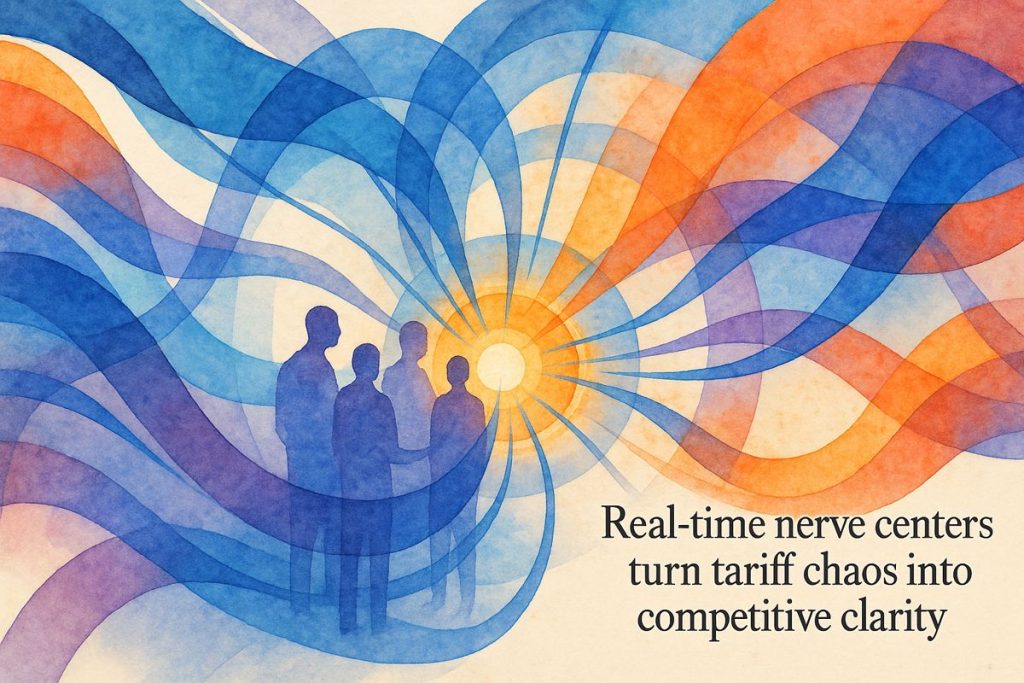Semiconductor companies are battling wild changes in trade rules and tariffs in 2025. To survive, they’re building high-tech digital “nerve centers” that watch their supply chains like mission control, using real-time data, smart simulations, and blockchain for tracking. They’re also finding new suppliers, safer routes, and working more closely with partners across the globe. Every small move—like a late-night tariff announcement—can shake the whole industry, so these new nerve centers help them react fast and keep chips flowing, even when the rules change overnight.
How are semiconductor companies adapting to the 2025 tariff changes?
Semiconductor companies are adapting to 2025 tariff changes by establishing centralized digital “nerve centers” for real-time supply chain monitoring, diversifying sourcing and logistics routes, enhancing traceability with blockchain, and increasing collaboration with global partners. These strategies help manage costs, regulatory risks, and ensure resilient chip production.
The Unruly Weather of Semiconductor Trade
Picture this: it’s 8:12 a.m., a mug of Ethiopian Yirgacheffe in hand, and the Bloomberg terminal is blinking a fresh headline—tariffs on semiconductor imports are being ratcheted up (again), this time by a solid 25%. The room smells like roasted beans and burnt nerves. In 2025, the semiconductor industry, always a labyrinthine palimpsest of global dependencies, has entered what I like to call the “tariff meteorology” era. The rules of the game—tariffs, export controls, regulatory fine print—are shifting faster than a hyperspectral satellite scans the Gobi Desert.
Let’s not kid ourselves: the stakes are dizzying. A single percentage point uptick in materials tariffs can balloon fab costs by 0.64%. Now, factor in that building and running a fab in the U.S. is already 30–50% pricier than in Asia. The math? Brutal. That’s not a metaphor; it’s an economic migraine. Why, I wonder, does policy now seem to outmuscle innovation as the decider of who climbs (or slips off) the silicon summit? McKinsey’s dour numbers don’t lie, and Sourceability’s policy tips read like survival guides for the faint of heart.
And here’s the kicker: the finished chip may skirt some levies, but the rare-earth-laced tools and chemicals that birth it rarely escape unscathed. Supply chains—those delicate webs stretching from Hsinchu to Dresden—are now as brittle as spun sugar. Ugh.
Digital Nerve Centers: The New Cortex of Semiconductor Strategy
Out of this chaos, a curious phenomenon has crystallized: the rise of the centralized digital “nerve center.” I used to scoff—surely just another dashboard rebrand? But no, these “nerve centers” are closer to the mission control at NASA than to your run-of-the-mill ERP. Think: a war-room bristling with live feeds from customs, port authorities, suppliers, inventory beacons, and yes, the occasional outburst from Xinhua or Reuters.
Inside these digital sanctums, machine learning algorithms run ceaseless “what if?” drills. Imagine the scenario: new tariffs are announced at 2 a.m. in Washington. By dawn, the nerve center has run dozens of Monte Carlo simulations, flagged a vulnerability in the Tokyo logistics chain, and nudged operations to reroute a $40M shipment of lithography equipment. The sensory hum of servers in the background, the faint click of keyboards—this is where the industry’s pulse is taken in real time.
There’s a whiff of science fiction here, but also hard pragmatism. Blockchain ledgers track provenance and compliance, offering immutable receipts even an ISO auditor would envy. Jusda Global has been touting these advances—traceability is no longer a compliance afterthought, it’s a shield against regulatory whiplash. The old reactive scramble? That’s being quietly resigned to history, as McKinsey’s trade impact report makes clear.
Adaptation: Rerouting the Labyrinth
But if you think this is only about dashboards and data lakes, think again. The strategic rewiring runs deeper. Semiconductor outfits—TSMC, Intel, the usual suspects—are hedging their bets with gusto. Sourcing is being diversified, redundancy woven through supply lines like golden thread through a tapestry. New logistics routes are mapped (often at 3 a.m., fueled by, I confess, cold pizza and existential dread), and R&D centers are quietly decamping to Switzerland or Singapore when the tariff headwinds get too stiff.
I’ll admit it: last year, I underestimated just how quickly a minor policy announcement in Brussels could send shockwaves from the cleanrooms of Arizona all the way to the testing labs in Eindhoven. That was a rookie mistake. Now, digital infrastructure is the chessboard upon which advantage is fought for (and lost). The “nerve center” has graduated from nice-to-have to existential. Sourceability’s 2025 adaptation guide made that painfully obvious.
And through it all, there’s a strange pride. One gets to watch the industry’s collective IQ rise—not in a smooth arc, but in quantum leaps, every time a crisis is averted with seconds to spare.
The Partner Web and the Human Factor
Let’s not forget: the nerve center phenomenon is not a solitary pursuit. The ripple effects reach far beyond the corporate firewall. Vendors, freight operators, research partners—everyone is pulled into tighter, more transparent alignment. Sometimes it feels like a global orchestra tuning up, every player sweating the fine print of their regulatory sheet music.
A brief story: I once watched a partner in Taiwan pivot their entire logistics schedule on the strength of a single nerve center alert from a U.S. fab. Panic at first, then—bam!—relief, as the shipment slipped past a tariff window by hours. That cocktail of adrenaline and relief? Unforgettable.
The
